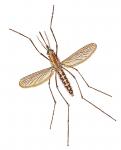Pest Identification
You're visiting our pest identification library with information about the biology and control of common household pests.
Mosquito
| Appearance |
|---|
 Pale brown with whitish stripes across abdomen; narrow oval shape; 1/4- to 3/8-inch. Females are easily recognized by long thin proboscis, or mouthparts, extending from the head. Pale brown with whitish stripes across abdomen; narrow oval shape; 1/4- to 3/8-inch. Females are easily recognized by long thin proboscis, or mouthparts, extending from the head. |
| Habitat |
| Mosquitoes breed in stagnant water sources such as storm drains, old tires, children's wading pools and birdbaths. They are one of the best known and most detested summer pests. Female mosquitoes bite humans and suck our blood, leaving behind welts and itching. While the United States is fairly free of most mosquito-borne diseases, encephalitis remains a problem, most notably the potentially fatal West Nile Virus. |
| Diet |
|
Female mosquitoes suck our blood. Male mosquitoes feed on plant nectars.
|
| Control |
| Mosquitoes are most active at dusk and dawn, so avoid going outdoors during those times. Use insect repellent containing DEET on exposed skin whenever or wherever mosquitoes are likely to bite. To eliminate or reduce mosquito breeding sites, replace all standing water at least once a week. This includes bird baths, ponds and unfiltered pools. Remove unnecessary vegetation and any trash from around standing water sources that cannot be eliminated. Make sure screens are in place on all doors, windows and other openings. |
Pest Library - BITING INSECTS Schedule a free inspection today






